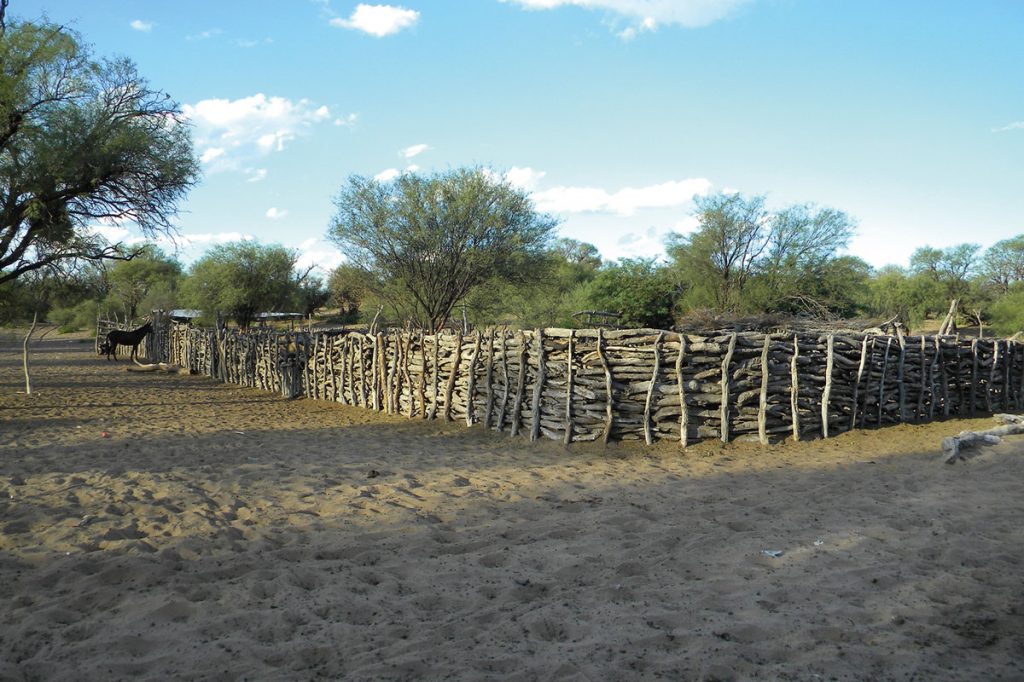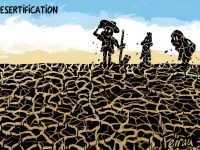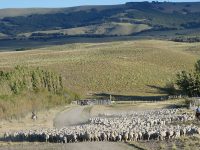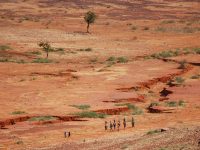Latin American drylands
Challenges and opportunities for sustainable development
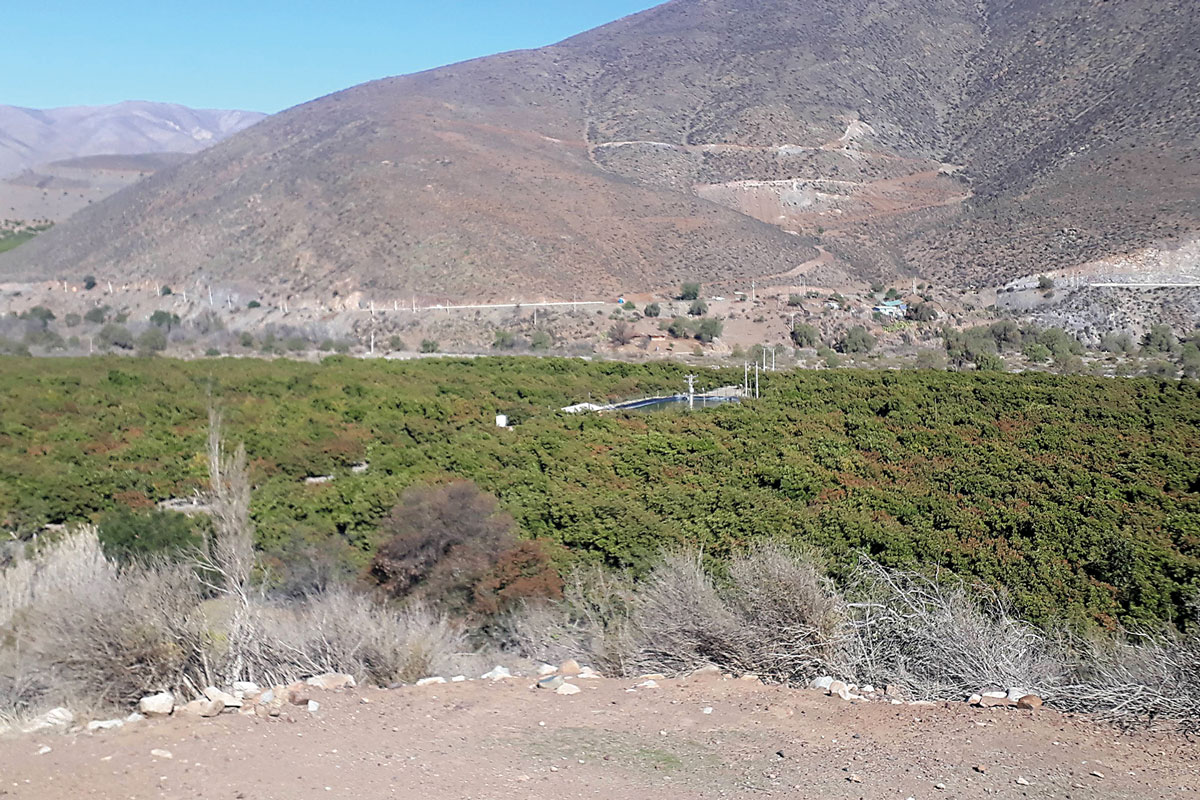
The drylands of Latin America sustain their countries’ economies. However, governance and economic models focused on exports and the short term have resulted in environmental injustice, unsustainable development, and the promotion of desertification. Addressing development challenges in water-limited ecosystems requires a thorough understanding of their complex socio-environmental interactions. In this document, we examine two of the most important economic activities in Latin American drylands: agriculture and mining. We use representative cases from Argentina, Bolivia, Chile, and Mexico to illustrate the complexity of socio-environmental interactions in which climate change affects the availability of water resources and results in power struggles. We also discuss how the approach to ecosystem services and transdisciplinary research can result in development models that benefit and protect ancestral communities and the ecosystems that make these territories unique.
Keywords: drylands, Latin America, water, sustainable development, environmental justice, desertification.
Introduction
Arid, semi-arid, and dry-sub-humid drylands cover 40 % of the Earth’s land surface and are home to about 2 billion people. Addressing development challenges in water-limited ecosystems requires a thorough understanding of their complex socio-environmental interactions. The American continent is home to 9.6 % of these aforementioned drylands, covering 12.8 million km2. From the hyper-arid Atacama Desert to the biodiverse Sonoran Desert, these spaces have hosted ancient cultures and still sustain much of the economies of these countries today.
In Latin American drylands, as in the rest of the world, anthropogenic activities are dominant drivers of global environmental change and desertification. Large-scale agricultural activities, uncontrolled urban development, and extractive activities, in combination with weak institutional frameworks, have fostered land-use changes that further compromise scarce water resources and the productivity of these ecosystems. In this paper, we examine some of the complex socio-environmental challenges facing these areas, and explore cases from Argentina, Bolivia, Chile, and Mexico. Our analysis aims to stimulate debate on what kind of sustainable and fair development might be possible for Latin American drylands, given current conditions and potential future developments.
Agriculture and the competition for water
Drylands are the historical home to many of the world’s major civilisations, partly due to their potential for agriculture. Throughout history, agriculture has represented the most significant use of water, and it currently consumes about 80 % of the total volume (Albrecht et al., 2018). Agriculture is therefore a key sector to consider in the debate on sustainable development in drylands.
Chile exemplifies the trade-off between agricultural productivity and sustainability, because, although 58 % of its territory is classified as drylands, a significant part of its economy is based on food exports (Donoso et al., 2016). Not only has climate change already reduced the accumulation of snow in the Andes Mountains, but the phenomenon of megadrought in the last decade in Chile has also reduced the expected average rainfall by up to 40 % (Garreaud et al., 2020). However, even before climate change, the country was already facing water management challenges because its legal system, implemented under the Pinochet dictatorship (1973–1981), is based on market logic. During this time, water use rights were granted on the premise that they would eventually be redistributed among activities and users according to cost-opportunity criteria (Bauer, 2004). It has now been proven that these water rights were not distributed, but rather were monopolised by the most competitive uses (Figure 1) and that ancestral activities, more vulnerable users, and uses with no market value (e.g., ecosystem conservation), never had a chance to access water (Carrasco, 2016). Currently, the sustainability of agriculture is in question, considering that the water available in most watersheds is already over-allocated. Moreover, climate change projections indicate that this situation will worsen in the future, affecting the sustainability of projects that aim to bring water from wetlands in the south to drylands in the north (Barría et al., 2021).
Figure 2. In the Argentine Province of Mendoza, water and the power dynamics encircling it are the main factors shaping the territory. The inhabitants, mostly of the Huarpe ethnic group, devote their lives to subsistence livestock farming. This image shows a traditional corral in the northeast of Mendoza. / Cecilia Vega Riveros, 2011A similar example is the Province of Mendoza in Argentina, where water and the power dynamics related to its use are the main factors shaping the territory. Since the beginning of the 20th century, the capture of water resources for wine production has reduced the flows of the rivers in Mendoza and San Juan, transforming the downstream territory from a system of lagoons and marshlands into a desert (Barzola-Elizagaray & Engelman, 2020). In this area, the inhabitants, mostly of the Huarpe ethnic group, devote their lives to subsistence livestock farming (Figure 2), the sale of fertilisers, and labour for irrigated areas. This ecosystem has lost about 80 % of its water-covered area since the 1980s (Montaña et al., 2005). Indeed, the entire lagoon area is now affected by degradation and shrinkage processes, including the areas of influence of the stockbreeding farms (Goirán et al., 2012). The poor infrastructure in these areas, ecosystem degradation, and a weak local economy, among other factors, feed vicious circles that maintain unsustainable practices and are aggravated by climate change and critical decreases in snowfall in the Andes Mountains, which also affects Chile.
The Mexican case provides similar examples to those already mentioned in the south of the continent. With just over 14 million people concentrated in five states, the arid northwest is also home to extensive irrigation districts that use water from large dams and overexploited aquifers, some of which are even salinised because of their location near the Gulf of California. These resources are used to produce foodstuffs for export markets, including beef carcasses and live cattle, pork, beer, fruits, and vegetables. These exports involve the movement of large volumes of virtual water out of arid and semi-arid watersheds with already vulnerable ecosystems, putting livelihoods and aquifers at risk (Lutz Ley et al., 2018). Indeed, the struggle for water between different sectors in this region of Mexico has already sparked serious social conflicts, as shown by the case of the Independence Aqueduct (Figure 3) that transfers water from the Yaqui Valley (in the south of the state of Sonora) to the municipality of Hermosillo (the state capital). In this case, the Yaqui Indigenous people led a frustrated struggle that they won in court, but in reality, lost (Varady et al., 2021). The dispute over water is also evident in the peri-urban areas of Hermosillo, which compete with the communal lands that are losing access to this resource as the city grows faster and faster, resulting in a loss of agricultural production for local consumption (Zuniga-Teran et al., 2021). Recently, the water conflict in north-western Mexico has escalated internationally because, due to the drought and poor management, by the second half of 2020 Mexico was unable to deliver the volume of cross-border water corresponding to the United States of America as per their 1944 bilateral treaties. This triggered a conflict with farmers using the dam system which would tentatively «pay» for this water. These protests even led to the death of a protester at the hands of the Mexican National Guard in the northern state of Chihuahua (Kitroeff, 2020).
Mining and local development
Mining is one of the oldest human activities in Latin American drylands, as well as a major source of employment. For example, 37 % of the world’s copper now comes from Chilean drylands, accounting for 55 % of the country’s exports (Oyarzún & Oyarzún, 2011). While agriculture is, in general terms, the largest consumer of water (Donoso et al., 2016), mining is the main consumer of groundwater in the northern regions and is the largest promoter of seawater desalination (Aitken et al., 2016). Mining activities are of evident economic importance for Chile, but there are different acceptance attitudes towards it among the population (Moffat et al., 2014). On the one hand, this activity is conducted under a water management system currently under examination as part of a process to draft a new constitution in the country. On the other hand, there is a history of pollution, usurpation, and failure to fully include the local population in decision-making processes in Chile (Ocampo-Melgar et al., 2019), all of which has impacted the relationship between society and mining. These activities have also impacted native fauna, for example, by increasing cases of roadkill of Andean camelid species such as vicuñas (Vicugna vicugna). Moreover, the effect, and mitigation measures related to this have not yet been properly documented (Mata et al., 2016).
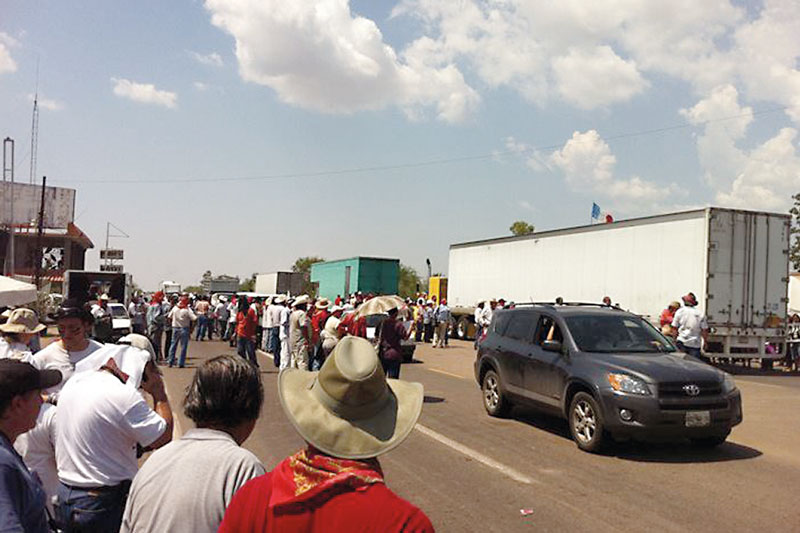
Figure 3. The struggle for water has sparked serious social conflicts. The image shows a demonstration cutting off the international highway in Sonora, Mexico, to protest the Independence Aqueduct. This infrastructure, built to supply water to the city of Hermosillo, was opposed by indigenous Yaqui farmers who felt that it would affect their water rights, because it would diminish the water supply to the La Angostura and Yaqui River dams. / Vicente Ivich, 2020
Bolivia is another country with a long-standing mining history, where the silver extracted from Cerro Rico in Potosí is part of the collective imagination of the Andes. After the previous inequitable distribution of benefits and costs in areas with a majority Indigenous population, one of the main local demands is access to decision-making processes (Bebbington, 2013). Nonetheless, studies show that business participation mechanisms and licences to operate have not yet created a real space for a shared sustainable development framework (Perrault, 2014). Furthermore, together with Chile and Argentina, Bolivia forms part of the so-called lithium triangle: a strategic geographical area where conflicts have increased due to international pressure towards industrialisation. In addition, one of the problems associated with lithium mining in the Puna grasslands is the limitations to the process of obtaining free, prior, and informed consent for mining in the area, as evidenced by the various clashes and conflicts between industrial mining and local livelihoods (Blair, 2021). The Plurinational Observatory of Andean Salt Flats (OPSAL), designed to distribute information regarding the impact of exploitation of the salt flats among local actors, activists, and academics, was formed because of these concerns.
Large-scale mining is also a major consumer of scarce and often contested water resources in North America (Figure 4). This activity, which brings significant economic gains to Mexico (2.4 % of the GDP in 2018; INEGI, 2018), is often placed in the vicinity of arid and semi-arid agrarian or peri-urban communities. The competition for water in these areas is asymmetrical between those who have the technological, economic, and legal resources to obtain it (the mines) and those who do not (the peasant and rural communities). The presence of mining threatens the present and future water security of communities and ecosystems because it can affect both the quantity and quality of the water available to its users (Lutz Ley, 2020). Of special note is the tragic acid leachate spill in the Sonora River in 2014, which impacted the health and economy of the local population (Díaz Caravantes et al., 2016). As in other examples in Latin America, large-scale mining activity in Mexico operates in the context of a liberal institutional framework, with the 1992 Mining Law and National Water Law promoting the priority and flexible use of natural resources by the mining sector, prioritising short-term economic benefits over social and environmental damage in the medium and long term.
Desolation or unique socio-environmental diversity
In the previous sections of this article we discussed the challenges faced by communities living in Latin American drylands. The use of water resources in these areas favours economic activities at the expense of the most vulnerable populations, particularly the ancestral communities that inhabit mostly rural areas. This is usually justified because rural drylands in Latin America are perceived as territories with little vegetation and a population dedicated to unprofitable economic activities.
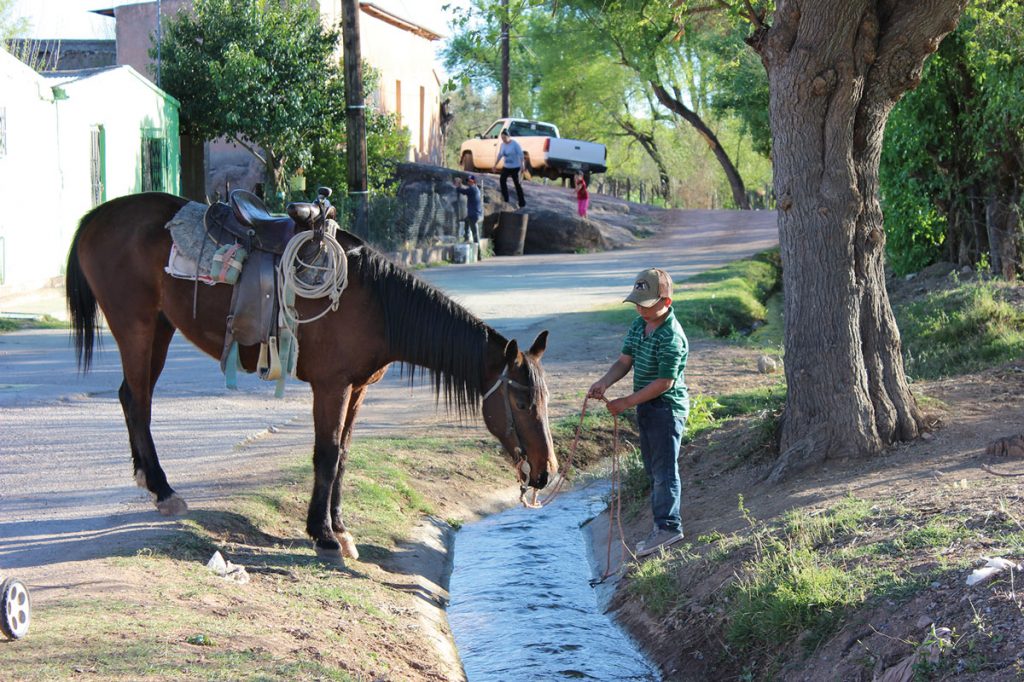
Figure 4. A boy allowing his horse to drink in an irrigation ditch in Cucurpe, Sonora, the host community of a Canadian-owned underground gold and silver mine. The presence of mining endangers the present and future water security of communities and ecosystems because it has the potential to affect both the quantity and quality of water available to local users. / América Lutz, 2015
However, the reality is that these seemingly desolate areas provide ecosystem services to local communities and the world at large. Although records exist in the academic literature that can help to identify the wide variety of plant species present in these areas, comprehensive studies connecting xerophytic formations and species associated with ecosystem services are scarce. Nonetheless, preliminary studies in Chile have shed some light on the connection between xerophytes and ecosystem services for local communities. For example, multiple health benefits have been recognised for native species in San Pedro de Atacama, Chile (Figure 5), as have cultural contributions that currently have no market value (Vita et al., 2006). The potential of the species commonly known as rica-rica (Acantholippia deserticola) has also been recognised, given its heritage and socio-cultural value to the surrounding communities, including multiple properties connected to the tourism sector (Parada et al., 2018). The economic value of native species in protected areas and the cultural relevance of biodiversity and its links to the rural economy have similarly been identified (Cerda et al., 2018).
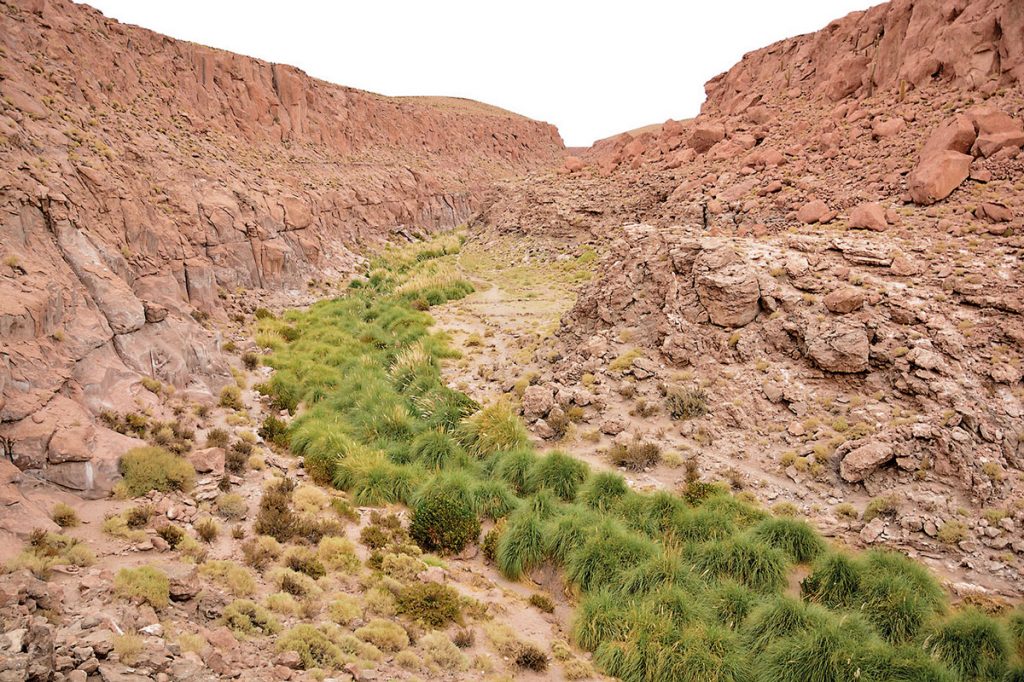
Figure 5. A ravine in the Atacama Desert, Antofagasta (Chile), showing the plant diversity of this type of environment. The rural drylands of Latin America are perceived as areas of sparse vegetation and population dedicated to unprofitable economic activities. However, the reality is that these seemingly desolate areas provide ecosystem services to local communities and the world at large. / Iñigo Bidegain, 2019
Advancing our understanding of ecosystem services can guide decision-making processes to identify the wide range of values associated with drylands. More interdisciplinary and transdisciplinary research to inform decision-makers about the connection between these ecosystems and the benefits they provide will not only make it possible to safeguard or preserve biodiversity but can also help us to recognise and minimise environmental injustice in these territories.
Conclusions
In Latin American drylands, water uses and development visions are competing in an increasingly pressing climate scenario. In this paper, we examined the Latin American drylands, territories of seemingly sparse vegetation with scattered populations that hide unique endemisms and ancestral cultures. However, this reality coexists with neoliberal economic models that focus on short-term economic development and disregard environmental and social externalities in the medium and long term. The cases of Argentina, Bolivia, Chile, and Mexico exemplify political and economic models sustained by mining and agricultural activities in arid zones. Inequitable access to benefits, as well as the exclusion of local communities in decision-making processes, generate conflicts between actors with diverse levels of power, where the most vulnerable are disadvantaged. Coupled with this, water governance is characterised by markets and legislation that prioritises private interests, increases inequity, and generates tension when constructing social values towards economic activities. On the one hand, economic activities bring employment and short-term benefits, but on the other, they strip these territories of their environmental, social, and cultural uniqueness, resulting in negative medium and long-term externalities.
Understanding the complex socio-environmental interactions that take place in these territories will help to address climate change and prevent desertification in Latin American drylands. Although the livelihood challenges faced by these communities are enormous, research on ecosystem services alongside local actors could provide an impetus for examples of small-scale economic development. These potential activities aim for sustainable development and the reduction of environmental injustice and could benefit local communities and help integrate ancestral knowledge. Thus, by prioritising ecosystem health over economic gain, Latin American drylands may be able to continue sustaining the lives of millions of people, as they have done for millennia.
References
Aitken, D., Rivera, D., Godoy-Faúndez, A., & Holzapfel, E. (2016). Water scarcity and the impact of the mining and agricultural sectors in Chile. Sustainability, 2(8), 128. https://doi.org/10.3390/su8020128
Albrecht, T. R., Varady, R. G., Zuniga-Teran, A., Gerlak, A. K., Routson De Grenade, R., Lutz-Ley, A., Martín, F., Megdal, S. B., Meza, F., Ocampo Melgar, D., Pineda, N., Rojas, F., Taboada, R., & Willems, B. (2018). Unraveling transboundary water security in the arid Americas. Water International, 43(8), 1075–1113. https://doi.org/10.1080/02508060.2018.1541583
Barría, P., Sandoval, I. B., Guzman, C., Chadwick, C., Alvarez-Garreton, C., Díaz-Vasconcellos, R., Ocampo-Melgar, A., & Fuster, R. (2021). Water allocation under climate change: A diagnosis of the Chilean system. Elementa: Science of the Anthropocene, 9(1), 00131. https://doi.org/10.1525/elementa.2020.00131
Barzola-Elizagaray, P., & Engelman, A. (2020). La vitivinicultura en Mendoza desde 1990: Entre la globalización y el desarrollo regional. Íconos. Revista de Ciencias Sociales, 66, 191–212. https://doi.org/10.17141/iconos.66.2020.3890
Bauer, C. J. (2004). Siren song: Chilean water law as a model for international reform. Routledge. https://doi.org/10.4324/9781936331062
Bebbington, D. H. (2013). Extraction, inequality and indigenous peoples: Insights from Bolivia. Environmental Science & Policy, 33, 438–446. https://doi.org/10.1016/j.envsci.2012.07.027
Blair, J. (2021). Extractivismo del litio y el problema de la escala: Acción climática global y justicia ambiental local. In R. Morales (Ed.), Salares andinos: Ecología de saberes por la protección de nuestros salares y humedales. Tanti.
Carrasco, A. (2016). A biography of water in Atacama, Chile: Two indigenous community responses to the extractive encroachments of mining. The Journal of Latin American and Caribbean Anthropology, 21(1), 130–150. https://doi.org/10.1111/jlca.12175
Cerda, C., Fuentes, J. P., De La Maza, C. L., Louit, C., & Araos, A. (2018). Assessing visitors’ preferences for ecosystem features in a desert biodiversity hotspot. Environmental Conservation, 45(1), 75–82. https://doi.org/10.1017/S0376892917000200
Díaz-Caravantes, R. E., Duarte Tagles, H., & Durazo- Gálvez, F. M. (2016). Amenazas para la salud en el río Sonora: Análisis exploratorio de la calidad del agua reportada en la base de datos oficial de México. Revista de la Universidad Industrial de Santander. Salud, 48(1), 91–96. https://doi.org/10.18273/revsal.v48n1-2016010
Donoso, G., Blanco, E., Franco, G., & Lira, J. (2016). Water footprints and irrigated agricultural sustainability: The case of Chile. International Journal of Water Resources Development, 32(5), 738–748. https://doi.org/10.1080/07900627.2015.1070710
Garreaud, R. D., Boisier, J. P., Rondanelli, R., Montecinos, A., Sepúlveda, H. H., & Veloso-Aguila, D. (2020). The central Chile mega drought (2010-2018): A climate dynamics perspective. International Journal of Climatology, 40(1), 421–439. https://doi.org/10.1002/joc.6219
Goirán, S. B., Aranibar, J. N., & Gomez, M. L. (2012). Heterogeneous spatial distribution of traditional livestock settlements and their effects on vegetation cover in arid groundwater coupled ecosystems in the Monte Desert (Argentina). Journal of Arid Environments, 87, 188–197. https://doi.org/10.1016/j.jaridenv.2012.07.011
INEGI. (2018). Minería. Instituto Nacional de Estadística, Geografía e Informática. https://www.inegi.org.mx/temas/mineria/
Kitroeff, N. (2020, 16 October). «Es una guerra»: La lucha por el agua estalla en la frontera de México. The New York Times. https://www.nytimes.com/es/2020/10/14/espanol/america-latina/chihuahua-mexico-pago-agua.html
Lutz Ley, A. N. (2020). Minería y seguridad hídrica en el noroeste de México: Un análisis de doble exposición. Región y Sociedad, 32, e1295. https://doi.org/10.22198/rys2020/32/1295
Lutz Ley, A. N., Lee, R. H., Peralta, Y., & Scott, C. A. (2018). Food and water security in North America’s transboundary Sonoran desert: A water-exporting dryland. In T. Allan, B. Bromwich, M. Keulertz, & A. Colman (Eds.), The Oxford handbook of food, water and society (pp. 344–362). Oxford University Press. https://doi.org/10.1093/oxfordhb/9780190669799.001.0001
Mata, C., Malo, J. E., Galaz, J. L., Cadorzo, C., & Lagunas, H. (2016). A three-step approach to minimise the impact of a mining site on vicuña (Vicugna vicugna) and to restore landscape connectivity. Environmental Science and Pollution Research, 23(14), 13626–13636. https://doi.org/10.1007/s11356-016-7047-9
Moffat, K., Boughen, N., Zhang, A., Lacey, J., Fleming, D., & Uribe, K. (2014). Percepciones chilenas hacia la minería: Encuesta a la ciudadanía – Resultados 2014. EP 147205. CSIRO.
Montaña, E., Torres, L. M., Abraham, E. M., Torres, E., & Pastor, G. (2005). Los espacios invisibles. Subordinación, marginalidad y exclusión de los territorios no irrigados en las tierras secas de Mendoza, Argentina. Región y Sociedad, 17(32), 3–32. https://doi.org/10.22198/rys.2005.32.a598
Ocampo-Melgar, A., Sagaris, L., & Gironás, J. (2019). Experiences of voluntary early participation in environmental impact assessments in Chilean mining. Environmental Impact Assessment Review, 74, 43–53. https://doi.org/10.1016/j.eiar.2018.09.004
Oyarzún, J., & Oyarzún, R. (2011). Sustainable development threats, inter-sector conflicts and environmental policy requirements in the arid, mining rich, northern Chile territory. Sustainable Development, 19(4), 263–274. https://doi.org/10.1002/sd.441
Parada, M., González, A., Rojas, C., & Vita, A. (2018). Caracterización del uso actual de la rica-rica (Acantholippia deserticola Phil. Moldenke) y recomendaciones para su manejo sustentable, en la Comuna de San Pedro de Atacama, Región de Antofagasta. Corporación Nacional Forestal, Región de Antofagasta. Facultad de Ciencias Forestales y de la Conservación de la Naturaleza, Universidad de Chile.
Perrault, T. (2014). Participación y poder: La consulta previa y sus descontentos en el sector minero de Bolivia. In B. Göbel & A. Ulloa (Eds.), Extractivismo minero en Colombia y América Latina (pp. 107–136). Universidad Nacional de Colombia.
Varady, R. G., Albrecht, T. R., Staddon, C., Gerlak, A. K., & Zuniga-Teran, A. A. (2021). The water security discourse and its main actors. In J. J. Bogardi, K. D. Wasantha Nandalai, R. R. P. van Nooyen, & A. Bhaduri (Eds.), Handbook of water resources management: Discourses, concepts and examples (pp. 215–252). Springer. https://doi.org/10.1007/978-3-030-60147-8_8
Vita, A., Serra, M. T., Carmona, R., & Urbina, C. (2006). Estudio etnobotánico y jurídico de hierbas nativas de la comuna de San Pedro de Atacama. (Unpublished report). Universidad de Chile, Facultad de Ciencias Forestales, Facultad de Derecho.
Zuniga-Teran, A. A., Mussetta, P. C., Lutz Ley, A. N., Díaz-Caravantes, R. E., & Gerlak, A. K. (2021). Analyzing water policy impacts on vulnerability: Cases across the rural-urban continuum in the arid Americas. Environmental Development, 38, 100552. https://doi.org/10.1016/j.envdev.2020.100552

